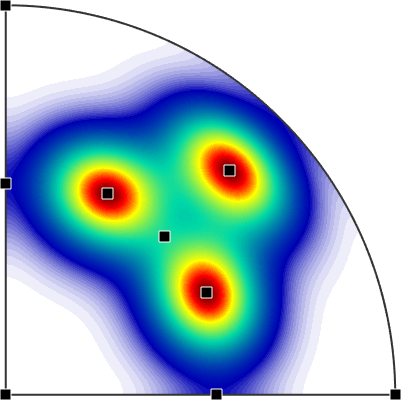By a variable of type S2Fun it is possible to represent an entire function on the two dimensional sphere. A typical example of such a function is the pole density function of a given ODF with respect to a fixed crystal direction.
% the famouse Santa Fe orientation distribution function
odf = SantaFe;
% the (100) pole density function
pdf = odf.calcPDF(Miller(1,0,0,odf.CS))pdf = S2FunHarmonicSym (y↑→x (222))
bandwidth: 25
antipodal: true
isReal: trueSince, the variable pdf stores all information about this function we may evaluate it for any direction r
% take a random direction
r = vector3d.rand;
% and evaluate the pdf at this direction
pdf.eval(r)ans =
0.7302We may also plot the function in any spherical projection
plot(pdf)
or find its local maxima
[~,localMax] = max(pdf,'numLocal',12)
annotate(localMax)localMax = vector3d (y↑→x)
size: 6 x 1
antipodal: true
x y z
0.665345 0.338549 0.665358
0.665332 0.665373 0.338544
0.338446 0.665332 0.665423
1 0 0
0 1 0
0 0 1
A complete list of operations that can be performed with spherical functions can be found in section Operations.
Representation of Spherical Functions
In MTEX there exist different ways for representing spherical functions internally.
|
harmonic expansion |
|
|
finite elements |
|
|
function handle |
|
|
Bingham distribution |
All representations allow for the same operations which are specified for the abstact class S2Fun. In particular it is possible to calculate with spherical functions as with ordinary numbers, i.e., you can add, multiply arbitrary functions, take the mean, integrate them or compute gradients.
Generalizations of Spherical Functions
|
spherical vector fields |
|
|
spherical axis fields |
|
|
radial spherical functions |
|
|
symmetric spherical functions |